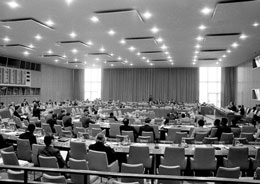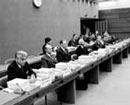|
Vienna Convention on Succession of States in Respect of Treaties
Vienna, 23 August 1978
By Anthony Aust
British Diplomatic Service (1967-2002), retiring as Deputy Legal Adviser Legal Adviser (Counsellor) to the United Kingdom Mission to the United Nations in New York, 1988-1991
In 1967, the International Law Commission (‘the Commission’) began work on the subject of succession of States in respect of treaties. In 1974, the Commission submitted to the United Nations General Assembly a final set of draft articles on Succession of States in respect of Treaties with a recommendation that the Assembly should convene a conference of plenipotentiaries to study the draft articles and conclude a convention on the subject. The General Assembly adopted resolutions 3496 (XXX) of 15 December 1975 and 31/18 of 24 November 1976 to this effect by which it accordingly decided that the draft articles should be considered by a United Nations Conference on Succession of States in respect of Treaties (‘the Conference’) to be held at Vienna from 4 April to 6 May 1997. The Conference was held as scheduled but partly because the draft articles raised some controversial issues it recommended that the General Assembly decide to reconvene the Conference in the first half of 1978 for a final session. The resumed session of the Conference, approved by General Assembly resolution 32/47 of 8 December 1981, was held at Vienna from 31 July to 23 August 1978 and resulted in the adoption of the 1978 Vienna Convention on Succession of States in respect of Treaties (‘the 1978 Convention’). Given the subject matter, there was no question of the 1978 Convention being based on the very successful 1969 Vienna Convention on the Law of Treaties (‘the 1969 Convention’). Instead, the Commission decided to deal with the subject as a question of succession. However, in appointing Sir Humphrey Waldock as the first Special Rapporteur (he had previously been its Special Rapporteur for the law of treaties), the Commission’s method of work would follow the pattern set by the elaboration of the draft articles on the law of treaties which eventually became the 1969 Convention. In 1973, Sir Francis Vallat succeeded Waldock for the last year of the Commission’s work on the subject. The 1978 Convention did not enter into force until 1996 when it achieved the necessary fifteen expressions of consent to be bound. This was almost eighteen years after its adoption. Entry into force only happened because, between 1991 and 1996, Bosnia and Herzegovina, Croatia, Estonia, Slovakia, Slovenia, the former Yugoslav Republic of Macedonia and Ukraine acceded or succeeded to the 1978 Convention. Not surprisingly, as new States they presumably thought it would be useful to them. Estonia is included as a new State even though it resumed its previous statehood. However, since it had been for fifty years de facto part of the Soviet Union, it had to resolve succession problems of some novelty. Although Byelorussia (now Belarus) and Ukraine had been part of the Soviet Union, as the result of a political deal involving also India (which became independent only in 1947) all three became founding Members of the United Nations. Yet, the former Soviet republics also had their own succession problems (on the particular treaty succession problems of Estonia, and Belarus and Ukraine, see A. Aust, Modern Treaty Law and Practice, 2nd ed., Cambridge, Cambridge University Press, 2007, pp. 377-8 and 376-7, respectively). Today, the 1978 Convention has but twenty-two parties, the most recent being the Republic of Moldova. So, why has the 1978 Convention not been more successful? The so-called Cold War was still an important factor when the 1978 Convention was adopted. As a consequence, some of the draft articles were adopted by separate votes. In addition, there was no general doctrine which resolved the problems of succession to treaties. In particular, the situations in which new States are created vary enormously, and a “one-size fits all” approach was quite unsuitable. The number of different theories of succession did not make the task of devising a text on the subject any easier. As a result, the 1978 Convention contains much that is contentious progressive development of international law. When the Commission was developing its draft articles (in the relatively short space of seven years) the most recent State practice related to former colonies but was not consistent. Consequently, those rules of the 1978 Convention which are concerned with newly independent States are excessively complex. They also give undue prominence to the so-called “clean slate” principle, and not enough weight to the abundant State practice of concluding devolution agreements or, even more importantly, making declarations of succession. Moreover, decolonisation was almost at its end by 1978, and, unless a successor State agrees otherwise, the 1978 Convention does not apply to a succession of States which occurs before its entry into force (6 November 1996). Nor did the 1978 Convention’s rules about the break-up of States reflect modern State practice, in particular the great variety of situations occurring at the end of the twentieth century. The reunification of Germany took place in 1990. The break-up of the Soviet Union occurred in 1991, and of Yugoslavia mainly between 1992 and 1993. The so-called velvet divorce of Czechoslovakia happened in 1993. In short, before the 1990s there was little of recent practice on which to draw. Although parts of the 1978 Convention may have been relied upon in drafting certain bilateral succession agreements – an example in point being the strong endorsement of article 34(1) (Succession of States in cases of separation of parts of a State) in the practices of the successor States to the former Czechoslovakia – its influence and practical value is likely to continue to be considerably less than that of the 1969 Convention. Notwithstanding the reference by the Arbitration Commission of the Conference for Peace in Yugoslavia (also known as the ‘Badinter Commission’) in its Opinions Nos. 1 and 9 to the 1978 Convention as embodying principles of international law, article 34 cannot necessarily be taken as reflecting customary international law. Although the 1978 Convention is an example of progressive development of international law, the customary rules of international law on succession of States in respect of treaties apply to most States, yet they are not reflected in the text of the 1978 Convention. Therefore, it is not a reliable guide to such rules of customary law on treaty succession. Yet, albeit its late entry into force, practice following the end of the Cold War and decisions of the International Court of Justice may now have breathed a little life into a few of its provisions (see Application of the Genocide Convention (Bosnia and Herzegovina v. Yugoslavia), I.C.J. Reports 1996, pp. 595 and 611-12 and Gabčíkovo-Nagymaros Project (Hungary/Slovakia), I.C.J. Reports 1997, pp. 7 and 72). But, they are unlikely to result in many States wanting now to be parties to the 1978 Convention. So, it may remain little more than an interesting historical document. This Introductory Note was written in August 2009.
Related Materials
At its first session, in 1949, the International Law Commission selected the subject of succession of States and Governments as one of the topics for codification without, however, including it in the list of topics to which it gave priority. At its fourteenth session, in 1962, the Commission was apprised of General Assembly resolution 1686 (XVI) of 18 December 1961, recommending that the Commission include on its priority list the topic of succession of States and Governments. The Commission decided to set up a Subcommittee on the Succession of States and Governments whose task was to submit to the Commission a preliminary report containing suggestions on the scope of the subject, the method of approach to the study and the means of providing the necessary documentation (A/CN.4/149 and Add.1, A/CN.4/150 and A/CN.4/151). At its fifteenth session, in 1963, the Commission considered and unanimously approved the report of the Subcommittee (A/5509).
Following the resignation of Mr. Lachs, the Commission decided, at its nineteenth session, in 1967, to deal with the three aspects of the topic in accordance with the broad outline of the subject laid down in the report of the Subcommittee in 1963. The Commission appointed Special Rapporteurs for the first two aspects of the topic, succession in respect of treaties and succession of States in respect of matters other than treaties. The Commission considered the sub-topic of succession of States in respect of treaties at its twentieth, twenty-second, twenty-fourth and twenty-sixth sessions, in 1968, 1970, 1972 and 1974, respectively. The Commission appointed Sir Humphrey Waldock and Sir Francis Vallat as the successive Special Rapporteurs for the sub-topic at its nineteenth and twenty-fifth sessions, in 1967 and 1973, respectively. In connection with its consideration of the topic, the Commission had before it the reports of the Special Rapporteurs, information provided by Governments and international organizations as well as documents prepared by the Secretariat. At its twenty-fourth session, in 1972, the Commission conducted the first reading of the draft articles on succession of States in respect of treaties. At that session, the Commission adopted on first reading a provisional draft with commentaries and, in accordance with articles 16 and 21 of its Statute, decided to transmit it to Governments of Member States for their observations. The General Assembly, in resolution 2926 (XXVII) of 28 November 1972, recommended that the Commission should continue its work on the sub-topic in the light of comments received from Member States on the provisional draft. In resolution 3071 (XXVIII) of 30 November 1973, the General Assembly recommended that the Commission complete at its twenty-sixth session, in 1974, the second reading of the draft on succession of States in respect of treaties, in the light of comments received from Member States. At its twenty-sixth session, in 1974, the Commission adopted the final text of the draft articles on the succession of States in respect of treaties, with commentaries (A/9610/Rev.1) and submitted it to the General Assembly with a recommendation that the General Assembly should invite Member States to submit their written comments and observations on the draft articles and should convene a conference of plenipotentiaries to study the draft articles and conclude a convention on the subject (A/9610/Rev.1). The General Assembly, in resolution 3315 (XXIX) of 14 December 1974, invited Member States to submit their written comments and observations on the draft articles prepared by the Commission and on the procedure by which and the form in which work on the draft articles should be completed. The following year, the Assembly, by resolution 3496 (XXX) of 15 December 1975, decided to convene a conference of plenipotentiaries in 1977 to consider the draft articles and to embody the results of its work in an international convention and such other instruments as it might deem appropriate. In the resolution, the General Assembly urged Member States which had not yet done so to submit as soon as possible their written comments and observations on the draft articles. On 24 November 1976, the General Assembly adopted resolution 31/18 by which it decided that the United Nations Conference on Succession of States in Respect of Treaties would be held from 4 April to 6 May 1977 at Vienna. The Conference was held as scheduled but, having been unable to conclude its work in the time available; it recommended on 6 May 1977 that the General Assembly decide to reconvene the Conference in the first half of 1978 for a final session (A/CONF.80/15). The resumed session of the Conference, approved by General Assembly resolution 32/47 of 8 December 1977, was held at Vienna from 31 July to 23 August 1978. The delegations of one hundred States participated in the Conference (eighty-nine States in the 1977 session and ninety-four States in the resumed session). On 22 August 1978, the Conference adopted the Vienna Convention on Succession of States in Respect of Treaties consisting of a preamble, fifty articles and an annex. The Final Act of the Conference, of which five resolutions adopted by the Conference form an integral part, was signed on 23 August 1978. The Convention was opened for signature on 23 August 1978 and remained open for signature until 31 August 1979 at United Nations Headquarters in New York. The Convention entered into force on 6 November 1996. Text of the Convention Selected preparatory documents General Assembly resolution 1686 (XVI) of 18 December 1961 (Future work in the field of the codification and progressive development of international law) The Convention entered into force on 6 November 1996. For the current participation status of the Convention, as well as information and relevant texts of related treaty actions, such as reservations, declarations, objections, denunciations and notifications, see:
|





